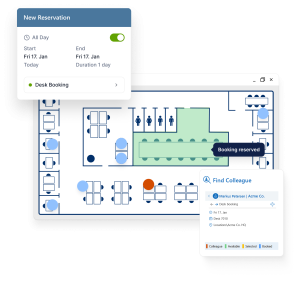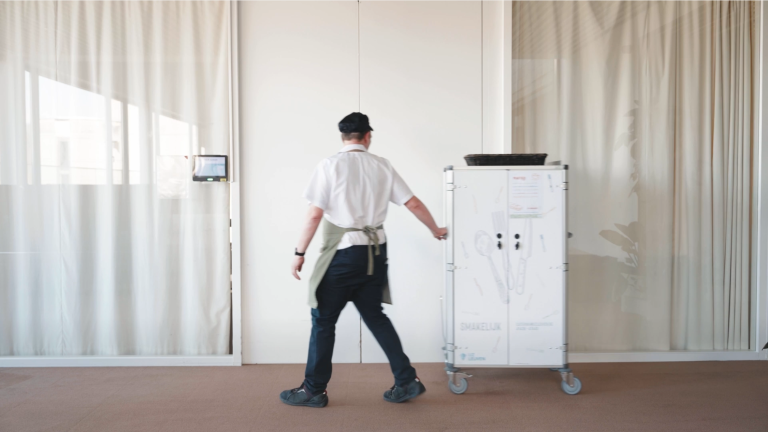Room utilization analytics empowers organizations to gain insights into how their meeting spaces and work areas are being used, allowing for informed decision-making. By systematically tracking occupancy rates, usage patterns, and space availability, companies can identify underutilized rooms and opportunities for reconfiguration. In short, room utilization analytics are an important part of the future of workplace management.
Practically, this means utilizing data-driven strategies to ensure meeting rooms match employees’ needs – whether that involves resizing, repurposing, or reallocating spaces based on actual usage. Moreover, effective room utilization can lead to significant cost savings, reduce waste, and foster a more collaborative work culture by creating spaces encouraging teamwork and innovation. As businesses increasingly prioritize agility and flexibility, harnessing the power of room utilization analytics is more important than ever in driving corporate efficiency.

Understanding Room Utilization Analytics
Room utilization analytics refers to the systematic collection and analysis of data regarding how meeting spaces and work areas are used in a corporate environment. By examining metrics such as occupancy rates, frequency of use, and duration of meetings, organizations can identify inefficiencies in space allocation and tailor their environments to suit employee needs better. This is one of many key workplace analytics that a successful organization should assess.
Data-driven insights facilitate optimal space management, allowing companies to repurpose underused areas and maximize resource efficiency. This leads to improvements in productivity and employee satisfaction.
With the rise of Industry 4.0, characterized by big data, the Internet of Things (IoT), and AI, room utilization analytics is set to evolve significantly. Advanced data analytics will enable real-time monitoring and predictive modeling of workspace usage patterns. Thus, organizations can dynamically adjust environments based on immediate needs, fostering a more responsive and adaptable workplace culture. The integration of these technologies will enhance decision-making and transform workplace management strategies in the future.
Benefits of Optimized Room Utilization
By identifying underused spaces through room utilization analytics, companies can significantly reduce overhead costs. Organizations can pinpoint underutilized areas by analyzing occupancy rates and usage patterns and either repurpose or consolidate them. This leads to lower rental or leasing expenses, as businesses can optimize their real estate footprint.
Moreover, optimizing space contributes to environmental sustainability. Reduced energy consumption from underused areas translates to lower electricity bills and a decreased carbon footprint. Implementing energy-efficient designs and technologies in these spaces fosters a culture of sustainability.
A notable example is Starbucks, which utilized space analytics to streamline store layouts, reducing energy costs and enhancing customer flow. Similarly, IBM has successfully implemented room utilization systems to manage its office environments effectively, driving cost savings and improved employee satisfaction. These companies demonstrate that strategic space management cuts costs and aligns corporate practices with environmental responsibility.

Overcoming Challenges in Implementation
Organizations often face barriers to addressing cybersecurity concerns, such as employee privacy apprehensions and the risk of data breaches. Employees may hesitate to embrace security protocols, fearing that they will overreach into their privacy. To overcome this, clear policies should be established that balance security measures with respect for employee privacy. Transparent communication about the purpose and scope of security protocols can foster trust and cooperation.
There are many cybersecurity threats in 2025, and they often rely on exploiting employees more than computer networks. Regular training and awareness programs can empower employees to recognize threats — like phishing attempts — while enlightening them on the importance of strong passwords and multi-factor authentication. Implementing strict access controls based on the principle of least privilege can further mitigate insider threats, which have increased significantly.
By combining clear policies, employee education, and advanced security practices, organizations can enhance their cybersecurity posture while respecting employee privacy. Continuous assessment and adaptation to evolving threats will ensure a resilient defense against potential breaches.
Future Trends in Room Utilization Analytics
As hybrid work models gain traction, the integration of emerging technologies will revolutionize room utilization strategies. AI-driven automation will play a pivotal role by optimizing space allocation in real time and adapting to fluctuating occupancy patterns. Predictive analytics can forecast room demand based on employee schedules and preferences, allowing organizations to allocate resources efficiently and reduce underutilization.
Furthermore, as remote and in-office work blend, room utilization systems will increasingly incorporate employee feedback to tailor spaces that support collaboration and well-being. Smart sensors and IoT devices will provide granular data on occupancy levels, enabling companies to adjust their environments.
Harnessing Analytics for a Smarter Workplace
By leveraging data-driven insights, organizations can optimize space allocation, reduce underutilization, and create adaptable workspaces that align with employee needs. As hybrid work models become more prevalent, these analytics empower companies to make informed decisions, ensuring resources are allocated effectively based on real-time occupancy and demand forecasts.
Moreover, integrating advanced technologies, such as AI and IoT, can further enhance operational efficiency and employee satisfaction by enabling personalized and collaborative environments. Embracing room utilization analytics positions organizations to respond swiftly to changing workplace dynamics and fosters a culture of innovation and productivity.
Free online demo
A member of our experienced team is ready to give you a short demo of any one of our products.
Request Demo




